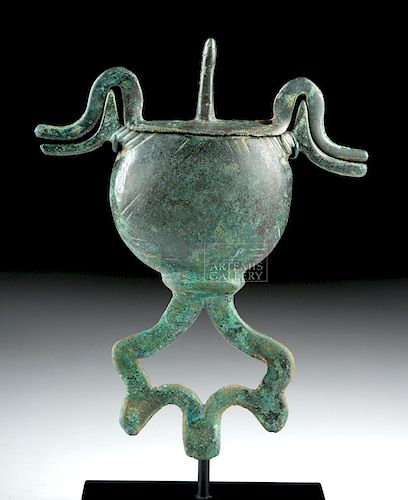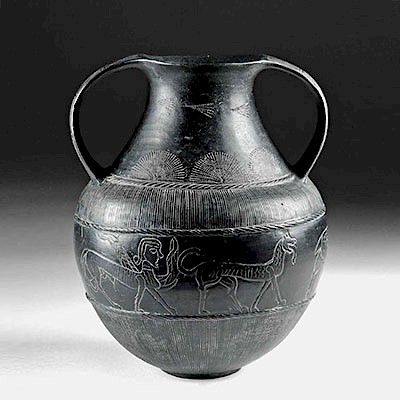Greek Geometric Bronze Pyxis - Sickle Type w/ Birds
Lot 13
About Seller
Artemis Fine Arts
686 S Taylor Ave, Ste 106
Louisville, CO 80027
United States
Selling antiquities, ancient and ethnographic art online since 1993, Artemis Gallery specializes in Classical Antiquities (Egyptian, Greek, Roman, Near Eastern), Asian, Pre-Columbian, African / Tribal / Oceanographic art. Our extensive inventory includes pottery, stone, metal, wood, glass and textil...Read more
Estimate:
$1,500 - $2,000
Absentee vs Live bid
Two ways to bid:
- Leave a max absentee bid and the platform will bid on your behalf up to your maximum bid during the live auction.
- Bid live during the auction and your bids will be submitted real-time to the auctioneer.
Bid Increments
| Price | Bid Increment |
|---|---|
| $0 | $25 |
| $300 | $50 |
| $1,000 | $100 |
| $2,000 | $250 |
| $5,000 | $500 |
| $10,000 | $1,000 |
| $20,000 | $2,500 |
| $50,000 | $5,000 |
| $100,000 | $10,000 |
| $200,000 | $20,000 |
About Auction
By Artemis Fine Arts
Mar 21, 2019
Set Reminder
2019-03-21 10:00:00
2019-03-21 10:00:00
America/New_York
Bidsquare
Bidsquare : Fine Ancient | Asian | Ethnographic Art
https://www.bidsquare.com/auctions/artemis-gallery/fine-ancient-asian-ethnographic-art-3967
Featuring classical antiquities, ancient and ethnographic art from cultures encompassing the globe, plus fine art. Egyptian, Greek, Roman, Etruscan, Near Eastern, Asian, Pre-Columbian, Native American, African / Tribal, Oceanic, Spanish Colonial, Russian, Fine Art, so much more! Artemis Fine Arts info@artemisgallery.com
Featuring classical antiquities, ancient and ethnographic art from cultures encompassing the globe, plus fine art. Egyptian, Greek, Roman, Etruscan, Near Eastern, Asian, Pre-Columbian, Native American, African / Tribal, Oceanic, Spanish Colonial, Russian, Fine Art, so much more! Artemis Fine Arts info@artemisgallery.com
- Lot Description
Ancient Greece, Geometric period, ca. 8th century BCE. A lidded pyxis with a flattened, globular body decorated with incised striations at the shoulder and a pair of abstract bird protomes at the rim, and an openwork, symmetrical ornament at the lower end. The lid also has bird protomes that fit neatly against those at the rim and a single vertical post/handle. This form of pyxis is called a "sickle" type, since its shape resembles that of a sickle, most likely used to hold perfumed oils or precious objects. Perforations just before the protomes of the lid and container were used to fasten the piece together in order to safeguard the contents and allow the pyxis to be suspended as a pendant via the protruding central element with its double perforations. Size: 3.45" W x 4.2" H (8.8 cm x 10.7 cm); 5.05" H (12.8 cm) on included custom stand.
Such pyxides have been found in necropolises. Based upon their positioning in the grave, experts believe that these pieces were suspended from the belts of the deceased. While two pyxides of a similar form were found at Samos, the type is believed to have originated in Macedonia.
Provenance: private East Coast, USA collection; ex-Gorny & Mosch (auction 140, June 21, 2005, lot 300); ex-private German collection, acquired in the 1990s
All items legal to buy/sell under U.S. Statute covering cultural patrimony Code 2600, CHAPTER 14, and are guaranteed to be as described or your money back.
A Certificate of Authenticity will accompany all winning bids.
We ship worldwide and handle all shipping in-house for your convenience.
#137291Small losses to peripheries of lid; otherwise in very nice condition with a pretty mottled deep green patina.Condition
- Shipping Info
-
All shipping is handled in-house for your convenience. Your invoice from Artemis Gallery will include shipping calculation instructions. If in doubt, please inquire BEFORE bidding for estimated shipping costs for individual items.
-
- Buyer's Premium



 EUR
EUR CAD
CAD AUD
AUD GBP
GBP MXN
MXN HKD
HKD CNY
CNY MYR
MYR SEK
SEK SGD
SGD CHF
CHF THB
THB















